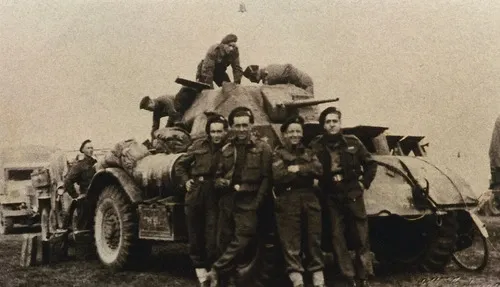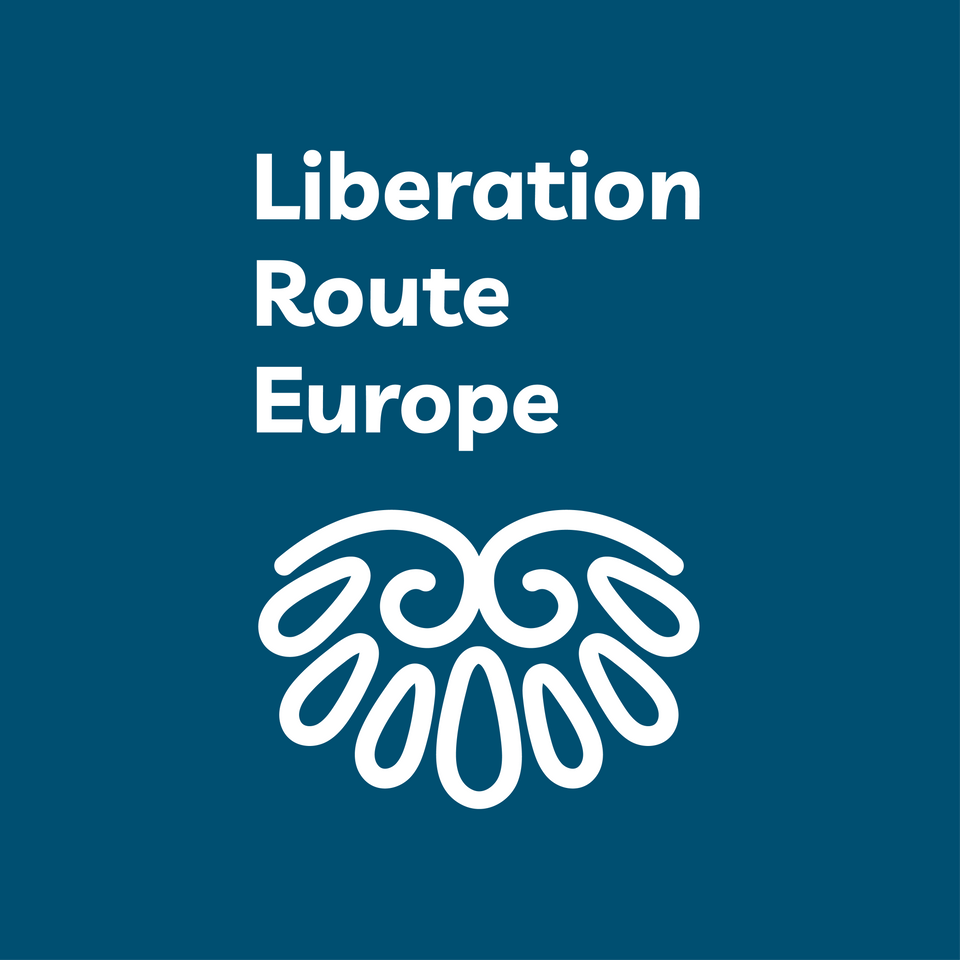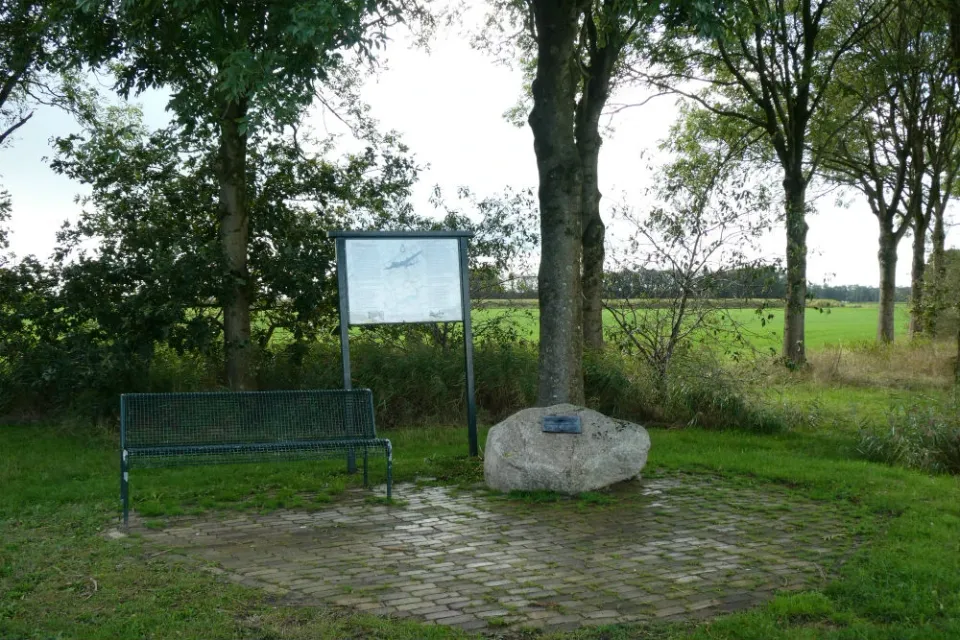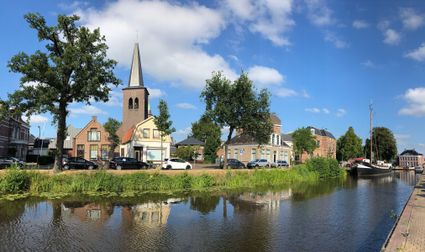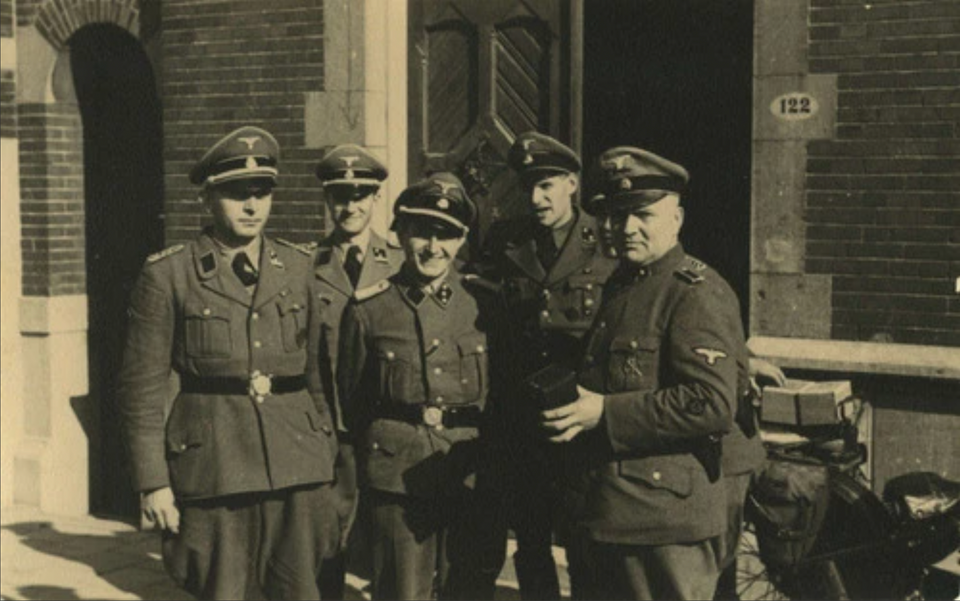Wolvega-Akkrum | Liberation route: section 1
After the Allied airborne troops were defeated at Arnhem in September 1944, it took until March 1945 for the Allies to go on the offensive again. After that, however, things moved quickly. The German forces in Gelderland and Overijssel had been severely weakened and were outnumbered. Backed by an effective Frisian resistance, Friesland was eventually liberated at a rapid pace.
In early April, it became clear that the liberation of Friesland was imminent. Although the province had not suffered a real Hunger Winter like other parts of the Netherlands, there were severe shortages of just about everything. And the terror of the occupying forces was growing. This also led to increased resistance against the occupying forces. The battle between the two was tougher than ever in early 1945.
In Friesland, ass…
After the Allied airborne troops were defeated at Arnhem in September 1944, it took until March 1945 for the Allies to go on the offensive again. After that, however, things moved quickly. The German forces in Gelderland and Overijssel had been severely weakened and were outnumbered. Backed by an effective Frisian resistance, Friesland was eventually liberated at a rapid pace.
In early April, it became clear that the liberation of Friesland was imminent. Although the province had not suffered a real Hunger Winter like other parts of the Netherlands, there were severe shortages of just about everything. And the terror of the occupying forces was growing. This also led to increased resistance against the occupying forces. The battle between the two was tougher than ever in early 1945.
In Friesland, assault groups known as Knokploegen (KP) were responsible for most acts of resistance. But there were other groups too. On the orders of the Dutch government in London, all these groups were merged into the Dutch Domestic Armed Forces (NBS). In Friesland, this happened on 12 December 1944.
The NBS, popularly referred to as the BS, gave the armed resistance an organisation with a clear structure. The NBS was also supposed to play a role in the upcoming liberation. To this end, resistance groups were provided with weapons from autumn 1944. These were dropped from the air.
On 8 April, Radio Orange broadcast the message "The bottle is empty." This was the signal for the NBS to start carrying out sabotage operations 36 hours later. The aim was to make it as difficult as possible for the Germans to defend themselves against the approaching Allied forces.
The resistance did this by putting bridges and railways out of order, blocking waterways and blocking roads. The response of the occupying forces was ruthless. In retaliation, dozens more prisoners were shot at different times and places.
Once the Canadians entered Friesland on 12 April, they were supported extremely effectively by the Frisian resistance. Because it was superbly organised, they were able to help the Canadians take control of important bridges, repair damaged bridges, and advise on the most favourable route.
By 18 April, the whole province was liberated except for the Wadden Islands (these were liberated in late May and in June). Compared to other provinces, there was little fighting in Friesland. Overall, the few thousand German troops who had been unable to flee Friesland were defeated by the Canadians relatively quickly.
The commander of the Royal Canadian Dragoons, Lieutenant Colonel Landell, praised the actions of the resistance by stating "Friesland liberated herself." While that may be a bit of an exaggeration, the actions of the Frisian resistance undoubtedly accelerated the liberation. And reduced the number of casualties on the Allied side.
In confrontations with German troops and their Dutch accomplices, at least 31 resistance fighters lost their lives. On the Allied side, at least eleven Canadians and one Frenchman were killed. The fighting and shelling also resulted in dozens of civilian casualties. The number of casualties on the German side is not known, but probably ran into the hundreds. With 320 houses destroyed and 4,000 damaged and 80 bridges destroyed, Friesland was materially the least damaged province in the Netherlands.
Liberation Route Europe is a transnational memorial. A route that connects memorial sites and stories from all over Europe. For more information, visit www.liberationroute.com
Sights on this route
Starting point:
Waypoint walk 49
Wolvega
Navigate to starting point
Waypoint walk 49
Wolvega
Navigate to starting point
Wolvega (Wolvegea)
Wolvega staat bekend om zijn paardendrafbaan. Het Victoriapark is één van de laatste vier overgebleven drafbanen van Nederland.
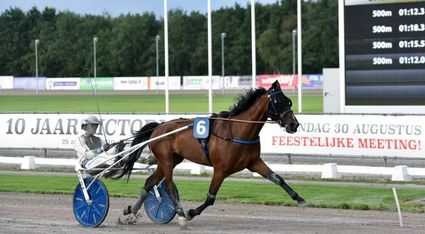
Sacrifice for freedom
In Wolvega's general cemetery, Allied honorary graves remind residents of the seven fallen crew members of the Lancaster JB 545 that crashed in the fields on the Sas (below Sonnega) on 16 December 1943.
Sacrifice for freedom
Near the crash site, the "Monument to Allied Airmen" was unveiled by the sister of one of the crew members in 2004 as a tribute to the fallen crew. A boulder with a plaque and a panel with background information on what happened keep the memory alive.
Of seven soldiers killed, five were British, one Canadian and one Australian. They were buried side by side. Identical white natural stone tombstones with an embossed emblem and cross have been placed at each grave. The cross is not only a symbol of the Christian faith, but also a reminder of the sacrifice made by war victims for a life of freedom.
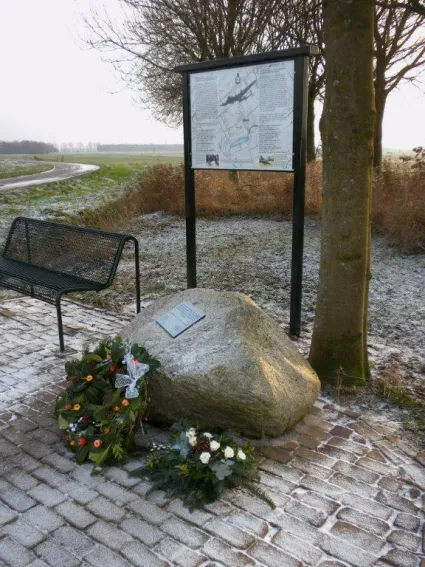
The battle for the Tjonger bridge in Mildam
In the afternoon of 12 April, rumours had reached Mildam that Englishmen or perhaps Canadians had been sighted at Peperga. The Canadian vanguards had entered Friesland.
The battle for the Tjonger bridge in Mildam
In the afternoon of 12 April, rumours had reached Mildam that Englishmen or perhaps Canadians had been sighted at Peperga. The Canadian vanguards had entered Friesland. For the inhabitants of Mildam it was still a surprise when at first one and shortly afterwards another military vehicle with a few men in khaki-coloured overalls stopped at the bridge.
These vehicles were part of a patrol of "D" Squadron Royal Canadian Dragoons commanded by Lieutenant Homer Thomas. These Canadians established that unlike other bridges, the bridge in Mildam over the Tjonger had not yet been blown up by the occupying forces. The fact that the Tjonger bridge in Mildam had not been destroyed was due to the local resistance movement. The Germans had indeed planned to blow up this bridge as well. But at the risk of their own lives, resistance fighters had removed the detonators from the explosives affixed to the bridge.
The Squadron Commander immediately ordered all units to secure the bridge. And the Dutch Domestic Armed Forces were also requested to provide men. The precautions turned out to be justified. In the night of 12 to 13 April, German troops launched one of their few counter-attacks in the province of Friesland. From Heerenveen, they managed to surprise the Canadians in Mildam. They tried to regain control of the bridge three times. During the fierce fighting, Canadian vehicles were knocked out. But the Dragoons stood firm, and the Germans were driven off again. Mildam was freed.
Four Canadian soldiers were injured in the fighting. The number of casualties on the German side is unknown. There was property damage in Mildam, but no civilians were killed. With a little less luck, though, there would have been several Dutch casualties. In the early morning of 13 April, a group of dozens of resistance fighters approached the bridge at dusk from the direction of Nieuweschoot. This was the reinforcement requested by the Canadians on 12 April when the undamaged bridge was discovered. The resistance fighters were partly carrying captured German weapons and were not noticed by the Dragoons in the semi-darkness until late.
Lieutenant Thomas, mentioned earlier, almost gave the order to open fire. It was only at the last moment that it became clear that they were not Germans. The resistance members had managed to make themselves known by singing songs in English.
The preservation of the bridge was important. During the following days, the Canadians would make extensive use of the bridge to advance further in the direction of Leeuwarden and liberate the province of Friesland.
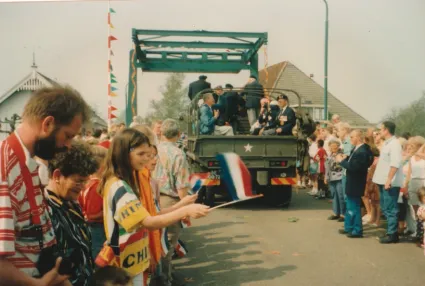
'Moordhol' Crackstate, het einde van de terreur
"Die morgen duurde langer dan ooit. Ik deed niets anders dan voor het raam staan te praten. Beneden in het park zei een man tegen mij dat de Canadezen in Bontebok waren." Verzetsman Jan Tuut zit op de ochtend van de bevrijding van Heerenveen nog gev...
'Moordhol' Crackstate, het einde van de terreur
"Die morgen duurde langer dan ooit. Ik deed niets anders dan voor het raam staan te praten. Beneden in het park zei een man tegen mij dat de Canadezen in Bontebok waren." Verzetsman Jan Tuut zit op de ochtend van de bevrijding van Heerenveen nog gevangen in Crackstate.
De gevangenis Crackstate is vanaf oktober 1944 het beruchte hoofdkwartier van mannen van de Sicherheits Dienst (SD), die opgejaagd door de geallieerden vanuit België naar het noorden trekken. Er worden talloze gevangenen vreselijk mishandeld, gemarteld en zelfs doodgeschoten. Op het hoogtepunt zitten er 200 tot 300 mannen en vrouwen gevangen. In een vijfpersoons-cel worden soms tientallen mensen opgesloten. Een dag voor de bevrijding dreigen de Duitsers nog de boel op te blazen.
De Canadese bevrijders naderen Heerenveen op 14 april via Mildam. Duitse troepen leveren hardnekkig strijd in dit gebied en er wordt flink met tanks geschoten. De vijftig à zestig gevangenen zitten in doodsangst in Crackstate vast en horen het lawaai in de verte. Totdat bakker Gerlof de Wolf en zijn knecht Hendrik rond half drie vermoeden dat de vijand uit de stad vertrokken is.
De Wolf woont schuin tegenover Crackstate en kent de situatie goed en hij hoort waar de sleutels liggen. Bedacht op bommen en boobytraps sluipen ze voorzichtig door de open voordeur naar binnen. Ze weten de gevangenen uit de cellen te krijgen. In stilte verlaat iedereen de gevangenis met de opdracht om zo snel mogelijk onder te duiken. Er verschijnen zo nu en dan nog Duitsers in de stad. Het blijft levensgevaarlijk.
Schrikbewind
Voordat de SD onder leiding van SS-Hauptsturmführer Kronberger het schrikbewind begint, pleegt het verzet in september 1944 zes man sterk een overval. Ze weten twee gevangen 'illegalen' te bevrijden. Er wordt in maart 1945 overwogen nog een keer een overval te plegen, maar het risico is te groot.
Een paar dagen voor de bevrijding ontvangt Kronberger een dreigbrief van de Nederlandse Binnenlandse Strijdkrachten (NBS). Het is de communistische Districts Operatie Leider (DOL) die hem waarschuwt geen gevangen meer te doden. Een merkwaardig kat-en-muis-spel gaat hieraan vooraf tussen Kronberger en de Districts Operatieleider (DIC) die in Crackstate gevangen zit.
Kronberger sluit een deal in ruil voor vrijlating en de belofte dat de DIC en zijn plaatsvervanger, de 'communistische' DOL terugkeren. De angst voor de 'communistische wraak' van de DOL is blijkbaar groot. Als de DIC en DOL uiteraard niet terugkeren, worden twee gevangenen bij Luinjeberd door de SD vermoord. Meer dan zestig gevangenen overleven hun verblijf in Crackstate niet door marteling, executie of transport naar kampen. Kronberger wordt na de oorlog tot veertien jaar veroordeeld.
Aan het begin van de avond van de 14e april, bereiken de Canadezen eindelijk Heerenveen-Zuid. Rond 19.00 uur halen de bewoners de bevrijders met veel gejuich binnen. Achtergebleven Duitsers schieten dan plotseling toch nog op de feestvierende menigte. Er vallen geen slachtoffers. De volgende dag is heel Heerenveen bevrijd en worden 'landverraders' en gevangengenomen Duitsers opgesloten in Crackstate. Het Huis van Bewaring dient nog enige tijd voor de internering van NSB-ers. In 1973 wordt het afgebroken en in 1995 wordt er een monument voor de slachtoffers onthuld.

Akkrum
Akkrum is a charming watersports village in the heart of the Frisian lake district, near the National Park De Alde Feanen.
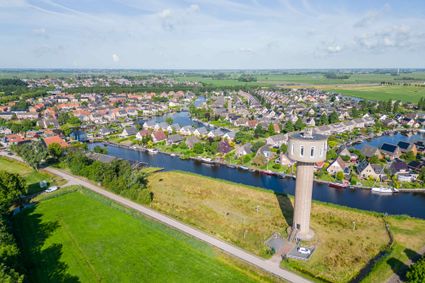
End point:
Waypoint walk 19
Akkrum
Navigate to endpoint
Waypoint walk 19
Akkrum
Navigate to endpoint
Directions
Starting point:
Waypoint walk 49
Wolvega
Navigate to starting point
The story of the Liberation of Western Europe is a book with many chapters, with some starting before the beginning of the war in 1939 and some others often ending years after the end of the conflict in 1945. Through the Liberation route Europe, you learn more about the storylines, key military events, personal stories and biographies from the second world war in Europe. Check out www.liberationroute.com for more routes, fragments and stories.
End point:
Waypoint walk 19
Akkrum
Navigate to endpoint
- 49
- 18
- 13
- 14
- 71
- 77
- 48
- 49
- 40
- 41
- 61
- 60
- 08
- 03
- 19
- 24
- 21
- 22
- 47
- 89
- 57
- 88
- 74
- 71
- 77
- 90
- 35
- 25
- 25
- 56
- 23
- 24
- 18
- 16
- 19
